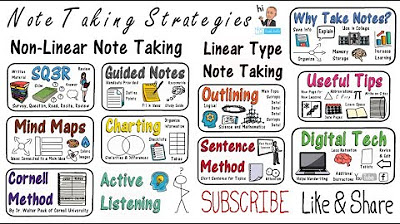How to Take Notes in Class: The 5 Best Methods - College Info Geek
Summary
TLDRThis video explores the top five note-taking systems for effective class learning: the Outline Method, Cornell Method, Mind Map Method, Flow Method, and Write on Slides Method. Each is personified by a Street Fighter character to illustrate their unique features. The Outline Method is structured and hierarchical, while the Cornell Method includes a summary and cue column for review. Mind maps create visual representations of topics, the Flow Method emphasizes learning through note-taking, and the Write on Slides Method offers a timeline view of lectures. The video invites viewers to find the system that best suits their learning style.
Takeaways
- 📚 There are five widely accepted note-taking systems: the outline method, the Cornell method, the mind map method, the flow method, and the write on the slides method.
- 📝 The outline method is straightforward, using bullet points and hierarchy to organize main points and details.
- 📑 The Cornell method divides notes into three sections: a note-taking column, a cue column for questions or cues, and a summary box.
- 🌐 The mind map method involves creating a visual representation of topics and subtopics, starting from a central idea and branching out.
- 🔄 The flow method encourages learning while taking notes, aiming to create an original document that represents the mental image of the subject.
- 🖥️ The write on the slides method involves writing notes directly on printed lecture slides, providing a timeline view of the lecture.
- 💻 Using a computer for the outline method is recommended for easy editing and formatting of notes.
- 🤔 The Cornell method is designed to facilitate review and summarization, with the aim of building reviewable notes during the initial write.
- 🧘 The mind map method can be useful for brainstorming and organizing complex ideas, as it visually connects related concepts.
- 🎓 Scott Young, known for completing the MIT computer science curriculum in a year, invented the flow method, which focuses on learning and understanding over transcription.
- 👨🏫 The write on the slides method can be convenient when lecture slides are available, reducing the amount of writing and providing a structured note format.
Q & A
What are the five note-taking systems mentioned in the script?
-The five note-taking systems mentioned are the outline method, the Cornell method, the mind map method, the flow method, and the write on the slides method.
Which Street Fighter character represents the outline method and why?
-Ryu represents the outline method because it is straightforward, based on hierarchy, disciplined, and overall very simple, much like Ryu's character.
How does the outline method of note-taking work?
-The outline method involves creating top-level bullet points for main points in a lecture and then adding lower-level bullet points for details. It is based on bullet points and hierarchy.
Who developed the Cornell note-taking method and when?
-The Cornell method was developed by Walter Pauk in the 1950s.
What are the three distinct sections used in the Cornell note-taking method?
-The three sections in the Cornell method are the cue column on the left, the note-taking column on the right, and a summary box underneath the columns.
How does the mind map method of note-taking differ from the other methods?
-The mind map method involves creating a visual representation of the lecture's main topic and subtopics by drawing branches from a central circle, which helps in organizing information in a more associative manner.
Which Street Fighter character represents the mind map method and why?
-Dhalsim represents the mind map method because he is a meditator and always focused on improving his mind, which aligns with the mindful organization of the mind map method.
What is the core concept of the flow method of note-taking?
-The flow method focuses on learning while sitting in class and creating an original document that represents one's mental image of the subject, rather than transcribing the lecture verbatim.
Which character from Street Fighter represents the flow method and why?
-Blanka represents the flow method because his fighting style is wild and freeform, much like the flexible and original approach to note-taking in the flow method.
How does the 'write on the slides' method simplify the note-taking process?
-The 'write on the slides' method simplifies note-taking by allowing students to write directly on printed lecture slides, which already outline the lecture's flow, reducing the amount of writing and providing a timeline view of the lecture.
Which Street Fighter character is used to represent the 'write on the slides' method and what is the reasoning?
-Zangief represents the 'write on the slides' method, possibly due to the speaker's humorous intent to not overthink the representation, as indicated by the script.
Outlines

このセクションは有料ユーザー限定です。 アクセスするには、アップグレードをお願いします。
今すぐアップグレードMindmap

このセクションは有料ユーザー限定です。 アクセスするには、アップグレードをお願いします。
今すぐアップグレードKeywords

このセクションは有料ユーザー限定です。 アクセスするには、アップグレードをお願いします。
今すぐアップグレードHighlights

このセクションは有料ユーザー限定です。 アクセスするには、アップグレードをお願いします。
今すぐアップグレードTranscripts

このセクションは有料ユーザー限定です。 アクセスするには、アップグレードをお願いします。
今すぐアップグレード5.0 / 5 (0 votes)






